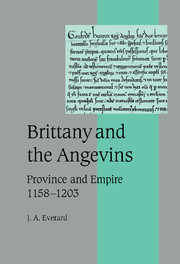Book contents
- Frontmatter
- Contents
- List of figures and maps
- Preface
- List of abbreviations
- Genealogy of the dukes of Brittany, 1066–1203
- The principal political divisions of Brittany, c. 1066
- Ducal domains, c. 1066–1186
- Introduction
- 1 Ducal Brittany, 1066–1166
- 2 Henry II and Brittany
- 3 The government of Brittany under Henry II
- 4 Duke Geoffrey and Brittany, 1166–1186
- 5 Duke Geoffrey, Henry II and the Angevin empire
- 6 The end of Angevin Brittany, 1186–1203
- Conclusion
- Appendices
- 1 The ‘Assize of Count Geoffrey’
- 2 The hereditary seneschals of Rennes
- 3 Angevin officers in Brittany
- 4 The right of Wreck and ducal brefs de mer
- Bibliography
- Index
- Cambridge Studies in Medieval Life and Thought Fourth series
2 - The hereditary seneschals of Rennes
Published online by Cambridge University Press: 15 December 2009
- Frontmatter
- Contents
- List of figures and maps
- Preface
- List of abbreviations
- Genealogy of the dukes of Brittany, 1066–1203
- The principal political divisions of Brittany, c. 1066
- Ducal domains, c. 1066–1186
- Introduction
- 1 Ducal Brittany, 1066–1166
- 2 Henry II and Brittany
- 3 The government of Brittany under Henry II
- 4 Duke Geoffrey and Brittany, 1166–1186
- 5 Duke Geoffrey, Henry II and the Angevin empire
- 6 The end of Angevin Brittany, 1186–1203
- Conclusion
- Appendices
- 1 The ‘Assize of Count Geoffrey’
- 2 The hereditary seneschals of Rennes
- 3 Angevin officers in Brittany
- 4 The right of Wreck and ducal brefs de mer
- Bibliography
- Index
- Cambridge Studies in Medieval Life and Thought Fourth series
Summary
The family of the seneschals of Rennes begins with the seneschal Mainfinit (c.1060–95), but the counts of Rennes/dukes of Brittany employed a household seneschal from the first half of the eleventh century, and the office seems have become hereditary by the middle of the century. This is the conclusion to be drawn from the fact that Mainfinit acquired his office by marrying Commater ‘senescalca’, the widow of the seneschal Geoffrey son of Glai, so that ‘redditus est ei omnis honor’ qui ad senescalciam Gauffredi pertinebat' (BN ms fr. 22331, p. 236).
Mainfinit in fact originated in Nantes and possibly joined the comital household when Conan II was briefiy acknowledged as count of Nantes from 1050 to 1054 (Preuves, cols. 409, 484; A. Chédeville and N.-Y. Tonnerre, La Bretagne féodale XIe-XIIIe siècle, Rennes, 1987, pp. 42–3). Mainfinit first appears with the title ‘siniscaldus Redonensis’ in the reign of Count Geoffrey Grennonat (1066–84) (Preuves, col. 428), presumably fol- lowing his marriage to the widow of Geoffrey son of Glai. Mainfinit had at least three sons: William, Walter (the name of Mainfinit's brother) and Agaat (Preuves, cols. 428, 463, 484, 566). Mainfinit disappears after going on the First Crusade in the entourage of Duke Alan IV (Preuves, col. 484). On the duke's return there appears a new seneschal, William (Preuves, cols. 504–5, 512).
- Type
- Chapter
- Information
- Brittany and the AngevinsProvince and Empire 1158–1203, pp. 204 - 206Publisher: Cambridge University PressPrint publication year: 2000



